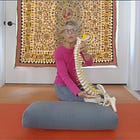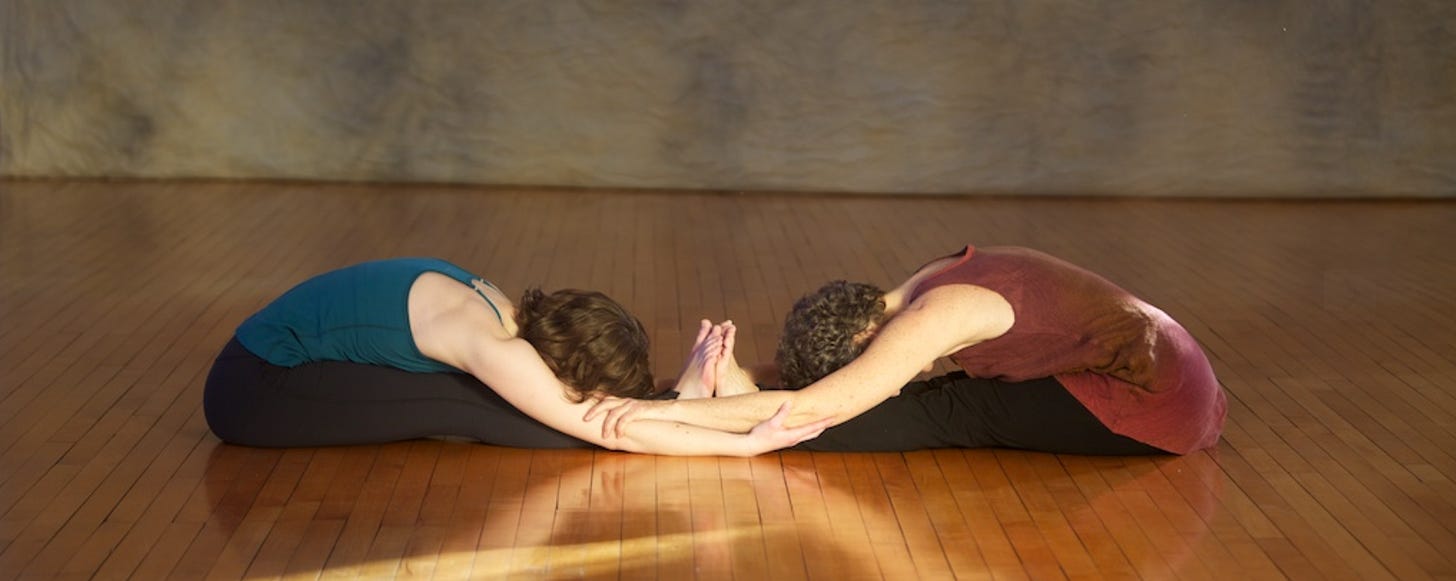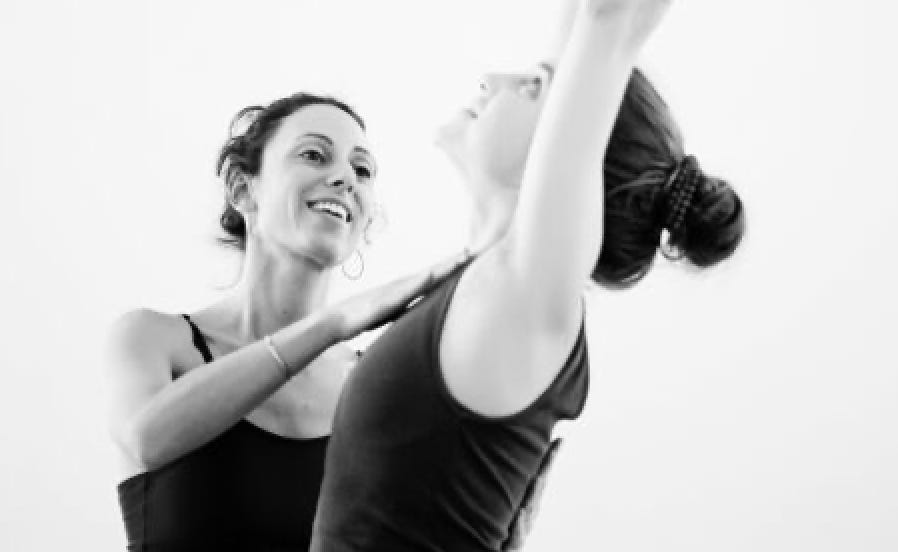Finding Grace in Backbending (Part Two)
From surrender to aspiration, backbends reveal the consciousness that moves through the spine.
In Part One of this series, we explored how to support and maintain an open heart while sustaining the spine’s integrity and ease. We looked at the importance of keeping the root alive by allowing the coccyx and pelvic floor to remain free and responsive.
If you missed the previous post, in two short videos we outlined a few of the basics: how to keep the heart can soft, the spine unified, and the coccyx and pelvic floor free.
Here in Part Two, we widen the frame to include more of the consciousness of the postures. We turn to the role of the organ body and the deep layers of soft tissue that provide essential support. Backbends are whole-body postures, involving layer upon layer of integrated structures.
When these layers are harmonized, each backbend becomes a symphony of opening — a gentle unfurling of what was held or restricted. We expand into what is new and refreshing, into possibilities that we may not have yet dreamed. And honestly, aren’t we more interested in the feeling — in the freeing aspect of opening into the vastness of who we are, into love — than in attaining any particular shape?
Forward Bending is Foundational for Backward Bending
Curling inward teaches us to soften, to accept, and to find comfort at our own center.
Backbending is an expansive movement outward from our center, opening to something beyond. Forward bending, by contrast, condenses us around our center and returns us to self. Forward bending is foundational for backbending. In forward bends we yield to the personal — our individual self. We take comfort and rest.
Forward bends are postures of surrender — and surrender is the foundation of effective aspiration. In yoga, surrender means yielding to the recognition and direct experience of the universality of consciousness that underlies the personal. It is not passivity or self-involvement. True surrender is alive, and it prepares us for effective action in the world.
In forward bends, we meet our own inner vulnerability. Condensing inward, we recognize our universal humanity and begin to nurture self-acceptance. From this self-comfort comes the impetus for expansion outward — toward our heart’s desire, our aspirations, and the sharing of our offerings. The more we rest in the universality of consciousness, the more fully we can know and express our aspirations. Depth of knowledge gives all our actions in the world greater power.
Forward bends are also where we yield to self at the most primal level — curled in our mother’s womb, being held close in feeding, and finding our own belly core for the first time through touch, gravity, and love. Then, we play on our bellies. This “belly play” builds the front body support that we will cherish for a lifetime. Not just muscle, but a profound relationship to gravity begins to grow as the whole body discovers integrated front support.
To further enhance what becomes true core strength, we curl around our bellies again and again — resting, feeding, gazing at our caregiver. In the best of situations, we are held in the safety of a curled spine and navel, only to rise and play once more. Like everything in life, there is an active and a resting phase to this early development. This primal pulsing of life itself underlies forward and backward bending: we explore, we rest, and then we rise again.
Explore:
Curl forward and feel your own soft belly center.
Yield — not collapsing, but softening into something both personal and Euniversal.
Sense the comfort of being held, and notice how self-acceptance arises.
Try the same thing as you come into a full forward bending posture. Be careful not to harden or push.
Backbends on the Continuum of Movement
Every bend lives on a continuum — forward and back weaving together in a single stream of life.
Backbending is not simply the opposite of forward bending. All movement is on a continuum. No gesture is purely forward or back, side to side, or in any single direction. Every movement in our living bodies arises from and recedes into every other movement. There is no stop and start — only the continuity of movement.
Our various directions are supported by consciousness, desire, and curiosity about life. We move because we are alive, woven of intelligence and form.
As we explore different movements in yoga, we are invited to slide through these continuums, to play with them, to recognize the consciousness each one holds, and to continue exploring the complexity of form and awareness that we are.
Within the particular continuum of bending forward and back, one supports the other. Forward bending quiets the mind. We may find comfort in curling around our deep belly organs. We slow down, turn inward, and even find nurturance in the touch and condensing of the front body tissues. Here, allowing and self-acceptance are cultivated. The nervous system is soothed. This embodied comfort and support becomes the ground for the outward opening of backbending.
Graceful backbending, then, arises from this continuum. Without it, backbends often harden into pushing efforts. Graceful backbending is elegant, soft, and beautiful. It doesn’t matter how far the spine bends; what matters is the consciousness expressed.
One of the key places the mind of the posture expresses itself is through the directional movement of the spine. When our focus turns inward for resting or nurturance, the spine naturally flexes. When our attention is captured by something in the world, the spine extends so we can look up, back, and around at what life presents.
If you are going backward, you go back with your whole being. The spine, the body, the self — all participate.
Explore:
Feel how every forward bend feeds your backbend.
Notice the continuity — no stop and start, just movement flowing both ways.
Let your spine shift naturally between curling in and opening out.
The Problem of Pushing
When we push to achieve, the heart hardens and the spine fragments. Grace dissolves.
Too often in backbends (and in forward bends), we see forces being pushed across the spine in an effort to “achieve” the posture. Pushing the heart forward hardens it, thrusting the chest outward. In the desire to open the heart, we may in fact be further hardening and restricting its natural expression.
Even subtle pushing creates shearing forces across the spine. This fragments our sense of integration and self through the central nervous system.
We may notice this fragmentation in our body’s inherent continuity — or not. For some, perhaps fragmentation never happens at all. Maybe you remain in a state of unity and ease throughout your yoga practice. Wonderful! For others, compartmentalizing and dividing the self may have become so familiar that we don’t yet realize it’s happening.
Explore:
Initiate a simple backbending movement. Notice if you’re pushing your heart forward rather than allowing it to uncurl.
What happens if you soften instead of push?
Sense whether your spine feels unified from head to tail or fragmented.
Feel for any harshness or shearing forces in your movement.
Interested students, teachers, and movers of all kinds,
I invite you to become a paid subscriber to unlock the rest of this article and join our ongoing explorations into embodying backbending.
Keep reading with a 7-day free trial
Subscribe to Patty Townsend | Embodyoga to keep reading this post and get 7 days of free access to the full post archives.






